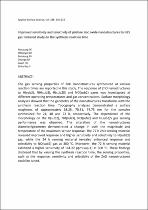 ResearchSpace
ResearchSpace
Improved sensitivity and selectivity of pristine zinc oxide nanostructures to H2S gas: Detailed study on the synthesis reaction time
JavaScript is disabled for your browser. Some features of this site may not work without it.
- ResearchSpace
- →
- Research Publications/Outputs
- →
- Journal Articles
- →
- View Item
| dc.contributor.author |
Motaung, David E

|
|
| dc.contributor.author |
Mhlongo, Gugu H

|
|
| dc.contributor.author |
Bolokang, Amogelang S

|
|
| dc.contributor.author |
Dhonge, Baban P

|
|
| dc.contributor.author |
Swart, HC

|
|
| dc.contributor.author |
Ray, Suprakas S

|
|
| dc.date.accessioned | 2017-07-28T09:36:13Z | |
| dc.date.available | 2017-07-28T09:36:13Z | |
| dc.date.issued | 2016-11 | |
| dc.identifier.citation | Motaung, D.E. et al. 2016. Improved sensitivity and selectivity of pristine zinc oxide nanostructures to H2S gas: Detailed study on the synthesis reaction time. Applied Surface Science, vol. 386: 210-223. https://doi.org/10.1016/j.apsusc.2016.06.014 | en_US |
| dc.identifier.issn | 0169-4332 | |
| dc.identifier.uri | http://www.sciencedirect.com/science/article/pii/S0169433216312326 | |
| dc.identifier.uri | https://doi.org/10.1016/j.apsusc.2016.06.014 | |
| dc.identifier.uri | http://hdl.handle.net/10204/9398 | |
| dc.description | Copyright: 2016 Elsevier. Due to copyright restrictions, the attached PDF file only contains the abstract of the full text item. For access to the full text item, kindly consult the publisher's website. | en_US |
| dc.description.abstract | The gas sensing properties of ZnO nanostructures synthesized at various reaction times are reported in this study. The response of ZnO nanostructures to H(sub2), NH(sub3), H(sub2)S and NO(sub2) gases was investigated at different operating temperatures and gas concentrations. Surface morphology analyses showed that the geometry of the nanostructures transforms with the synthesis reaction time. Topography analyses demonstrated a surface roughness of approximately 68.25, 70.31, 74.75 nm for the samples synthesized for 24, 48 and 72 h, respectively. The dependence of the morphology on the H(sub2), NH(sub3), NO(sub2) and H(sub2)S gas sensing performance was observed. The alteration of the nanostructures diameter/geometry demonstrated a change in both the magnitude and temperature of the maximum sensor response. The 72 h ZnO sensing material revealed improved response and higher sensitivity and selectivity to H(sub2)S gas, while the 24 h sensing material revealed enhanced response and selectivity to NO(sub2) gas at 300 °C. Moreover, the 72 h sensing material exhibited a higher sensitivity of 144.22 ppm(sup-1) at 300 °C. These findings disclosed that by varying the synthesis reaction time, the sensing properties, such as the response, sensitivity and selectivity of the ZnO nanostructures could be tuned. | en_US |
| dc.language.iso | en | en_US |
| dc.publisher | Elsevier | en_US |
| dc.relation.ispartofseries | Worklist;18068 | |
| dc.subject | ZnO-nanostructures | en_US |
| dc.subject | Nanorods | en_US |
| dc.subject | H2S sensing | en_US |
| dc.title | Improved sensitivity and selectivity of pristine zinc oxide nanostructures to H2S gas: Detailed study on the synthesis reaction time | en_US |
| dc.type | Article | en_US |
| dc.identifier.apacitation | Motaung, D. E., Mhlongo, G. H., Bolokang, A. S., Dhonge, B. P., Swart, H., & Ray, S. S. (2016). Improved sensitivity and selectivity of pristine zinc oxide nanostructures to H2S gas: Detailed study on the synthesis reaction time. http://hdl.handle.net/10204/9398 | en_ZA |
| dc.identifier.chicagocitation | Motaung, David E, Gugu H Mhlongo, Amogelang S Bolokang, Baban P Dhonge, HC Swart, and Suprakas S Ray "Improved sensitivity and selectivity of pristine zinc oxide nanostructures to H2S gas: Detailed study on the synthesis reaction time." (2016) http://hdl.handle.net/10204/9398 | en_ZA |
| dc.identifier.vancouvercitation | Motaung DE, Mhlongo GH, Bolokang AS, Dhonge BP, Swart H, Ray SS. Improved sensitivity and selectivity of pristine zinc oxide nanostructures to H2S gas: Detailed study on the synthesis reaction time. 2016; http://hdl.handle.net/10204/9398. | en_ZA |
| dc.identifier.ris | TY - Article AU - Motaung, David E AU - Mhlongo, Gugu H AU - Bolokang, Amogelang S AU - Dhonge, Baban P AU - Swart, HC AU - Ray, Suprakas S AB - The gas sensing properties of ZnO nanostructures synthesized at various reaction times are reported in this study. The response of ZnO nanostructures to H(sub2), NH(sub3), H(sub2)S and NO(sub2) gases was investigated at different operating temperatures and gas concentrations. Surface morphology analyses showed that the geometry of the nanostructures transforms with the synthesis reaction time. Topography analyses demonstrated a surface roughness of approximately 68.25, 70.31, 74.75 nm for the samples synthesized for 24, 48 and 72 h, respectively. The dependence of the morphology on the H(sub2), NH(sub3), NO(sub2) and H(sub2)S gas sensing performance was observed. The alteration of the nanostructures diameter/geometry demonstrated a change in both the magnitude and temperature of the maximum sensor response. The 72 h ZnO sensing material revealed improved response and higher sensitivity and selectivity to H(sub2)S gas, while the 24 h sensing material revealed enhanced response and selectivity to NO(sub2) gas at 300 °C. Moreover, the 72 h sensing material exhibited a higher sensitivity of 144.22 ppm(sup-1) at 300 °C. These findings disclosed that by varying the synthesis reaction time, the sensing properties, such as the response, sensitivity and selectivity of the ZnO nanostructures could be tuned. DA - 2016-11 DB - ResearchSpace DP - CSIR KW - ZnO-nanostructures KW - Nanorods KW - H2S sensing LK - https://researchspace.csir.co.za PY - 2016 SM - 0169-4332 T1 - Improved sensitivity and selectivity of pristine zinc oxide nanostructures to H2S gas: Detailed study on the synthesis reaction time TI - Improved sensitivity and selectivity of pristine zinc oxide nanostructures to H2S gas: Detailed study on the synthesis reaction time UR - http://hdl.handle.net/10204/9398 ER - | en_ZA |





